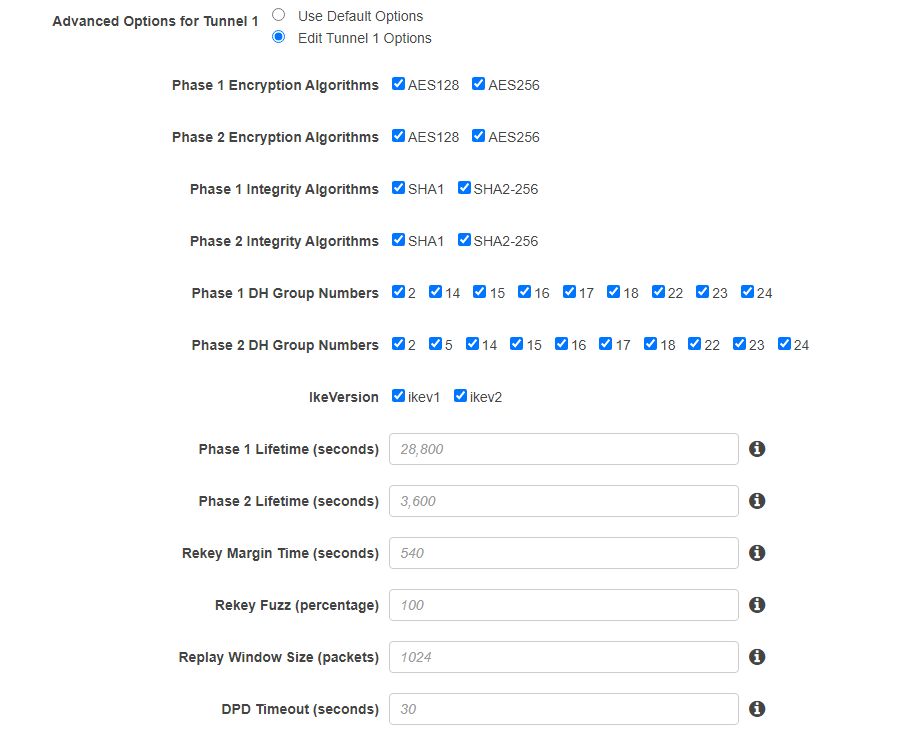
・オンプレミスのシステムとAWSをVPNで接続するには、どうしたらいいのかな?
・AWSでセキュアなVPN(IPSec)接続ができると、便利なんだけどなぁ
今回は、オンプレミスのシステム(以下、オンプレシステム)や自宅の環境とAWSをVPN(IPSec)でつなげたいって悩んでいる人向けにVPN設定方法を紹介します。
オンプレとAWSをVPN【IPSec】で接続する方法
オンプレシステムとAWSの接続でVPNを張って、通信を暗号化して、セキュリティ対策を行う設定を紹介します。
AWSのSite to Sito VPN【IPSec】設定
VPN【IPSec】接続に関する設定には、以下の3つの設定が必要です。
① カスタマーゲートウェイの作成
② 仮想プライベートゲートウェイの作成
③ サイト間のVPN接続(Site to Site VPN)の作成
カスタマーゲートウェイの作成
それでは、まずカスタマーゲートウェイの作成からです。
サービスを押し、「ネットワーキングとコンテンツ配信」の「VPC」を押します。
以下の画面が出るので、左の欄の「カスタマーゲートウェイ」を押します。
以下の画面が出るので、「カスタマーゲートウェイの作成」を押します。
以下の画面が出るんで、名前の入力、ルーティングの選択、IPアドレスの入力をします。
・名前「cs-gw」
・ルーティング「動的」 ←動的の場合BGPの設定になります。
– BGP ASN「65001」 ←オンプレシステムのBGPのAS番号を入力します。
・IPアドレス「153.50.60.24」←オンプレシステムの固定グルーバルIPを入力します。
・Carticate ARN ←デジタル証明書を使ってVPNを張る場合は事前に証明書の作成が必要です。(省略します)
・Device ←何のDeviceと接続するのかを入力します。(省略します)
入力を終えたら、「カスタマーゲートウェイの作成」を押します。
以下の画面が出て、カスタマーゲートウェイの作成が完了します。
「閉じる」を押します。
以下のようにcgwで始まるカスタマーゲートウェイが作成されました。
仮想プライベートゲートウェイの作成
次に左の欄の「仮想プライベートゲートウェイ」を押し、以下の画面の「仮想プライベートゲートウェイの作成」を押します。
以下の画面が出るので、名前タグを入力し、ASNを選択します。
・名前タグ「vgw-test1」
※画像からtestの部分消してしまいました・・・
・ASN「AmazonのデフォルトASN」 ←Amazon側でAS番号を払い出してもらいます。
※指定したい場合は、カスタムASNを選択します。
入力を終えたら、「仮想プライベートゲートウェイの作成」を押します。
以下の画面が出て、仮想プライベートゲートウェイの作成が完了します。
「閉じる」を押します。
以下のようにvgwで始まる仮想プライベートゲートウェイが作成されました。
サイト間のVPN接続(Site to Site VPN)の設定
次に左の欄のサイト間のVPN接続を押し、「VPN接続の作成」を押します。
以下の画面が出るので、名前タグの入力、Target Gateway Type、仮想プライベートゲートウェイ、カスタマーゲートウェイ、Customer Gateway ID、ルーティングオプションを選択します。
・名前タグ「vpn-test1」
・Target Gateway Type「Virtual Private Gateway」を選択します。
※Transit Gatewayを選択する場合は、複数拠点接続を行うハブの役割の設定です。
・カスタマーゲートウェイ「既存」を選択します。
・Customer Gateway ID「cgw-xxxxx」 ←先ほど作成したカスタマーゲートウェイの選択をします。
・ルーティングオプション「動的(BGPが必要)」を選択します。
※トンネルオプションでは、自分で決めたトンネル IPアドレスや事前共有キーを使いたい場合は入力します。(省略します。)
Advanced Options for TunnelにてEdit Tunnel Optionを選択すると、自分で暗号化アルゴリズム等を柔軟に決めることができます。(省略します。)
必要な設定が行ったら、2つ上の画面で掲載している右下の「VPN接続の作成」を押します。
以下の画面が出て、VPN接続の作成が完了します。
「閉じる」を押します。
以下の画面が出ます。
これで、AWS側のVPN設定が完了します。
今度はオンプレ側にAWSとVPNを張るための設定を行うため、「設定のダウンロード」を押します。
以下の画面が出ます。
今回はCiscoルータで設定するためのConfigをダウンロードします。
以下のように各種ベンダー、プラットフォーム、ソフトウェアが選択できます。
ベンダー「Cisco」を選択し、プラットフォームはISR Series routersを選択します。
ソフトウェアも「12.4+」を選択します。12.4以降のVerisonのIOSという意味です。
ダウンロードが完了するとテキストファイルで、以下のようにConfigがダウンロードできます。
! のところはコメントです。
それ以外のところをコピーして、お持ちのCiscoルータに設定を流し込みます。
! Amazon Web Services
! Virtual Private Cloud
! AWS utilizes unique identifiers to manipulate the configuration of
! a VPN Connection. Each VPN Connection is assigned an identifier and is
! associated with two other identifiers, namely the
! Customer Gateway Identifier and Virtual Private Gateway Identifier.
!
! Your VPN Connection ID : vpn-12345
! Your Virtual Private Gateway ID : vgw-12345
! Your Customer Gateway ID : cgw-12345
!
!
! This configuration consists of two tunnels. Both tunnels must be
! configured on your Customer Gateway.
!
! --------------------------------------------------------------------------------
! IPSec Tunnel #1
! --------------------------------------------------------------------------------
! #1: Internet Key Exchange (IKE) Configuration
!
! A policy is established for the supported ISAKMP encryption,
! authentication, Diffie-Hellman, lifetime, and key parameters.
! Please note, these sample configurations are for the minimum requirement of AES128, SHA1, and DH Group 2.
! Category "VPN" connections in the GovCloud region have a minimum requirement of AES128, SHA2, and DH Group 14.
! You will need to modify these sample configuration files to take advantage of AES256, SHA256, or other DH groups like 2, 14-18, 22, 23, and 24.
! NOTE: If you customized tunnel options when creating or modifying your VPN connection, you may need to modify these sample configurations to match the custom settings for your tunnels.
!
! Higher parameters are only available for VPNs of category "VPN," and not for "VPN-Classic".
! The address of the external interface for your customer gateway must be a static address.
! Your customer gateway may reside behind a device performing network address translation (NAT).
! To ensure that NAT traversal (NAT-T) can function, you must adjust your firewall !rules to unblock UDP port 4500. If not behind NAT, we recommend disabling NAT-T.
!
! Note that there are a global list of ISAKMP policies, each identified by
! sequence number. This policy is defined as #200, which may conflict with
! an existing policy using the same number. If so, we recommend changing
! the sequence number to avoid conflicts.
!
crypto isakmp policy 200
encryption aes 128
authentication pre-share
group 2
lifetime 28800
hash sha
exit
! The ISAKMP keyring stores the Pre Shared Key used to authenticate the
! tunnel endpoints.
!
crypto keyring keyring-vpn-12345-0
local-address 153.50.20.24
pre-shared-key address 13.113.91.95 key AAAAA_AAAAA_AAAAA
exit
! An ISAKMP profile is used to associate the keyring with the particular
! endpoint.
!
crypto isakmp profile isakmp-vpn-12345-0
local-address 153.50.60.24
match identity address 13.113.91.95
keyring keyring-vpn-12345-0
exit
! #2: IPSec Configuration
!
! The IPSec transform set defines the encryption, authentication, and IPSec
! mode parameters.
! Category "VPN" connections in the GovCloud region have a minimum requirement of AES128, SHA2, and DH Group 14.
! Please note, you may use these additionally supported IPSec parameters for encryption like AES256 and other DH groups like 2, 5, 14-18, 22, 23, and 24.
! NOTE: If you customized tunnel options when creating or modifying your VPN connection, you may need to modify these sample configurations to match the custom settings for your tunnels.
!
! Higher parameters are only available for VPNs of category "VPN," and not for "VPN-Classic".
!
crypto ipsec transform-set ipsec-prop-vpn-12345-0 esp-aes 128 esp-sha-hmac
mode tunnel
exit
! The IPSec profile references the IPSec transform set and further defines
! the Diffie-Hellman group and security association lifetime.
!
crypto ipsec profile ipsec-vpn-12345-0
set pfs group2
set security-association lifetime seconds 3600
set transform-set ipsec-prop-vpn-12345-0
exit
! Additional parameters of the IPSec configuration are set here. Note that
! these parameters are global and therefore impact other IPSec
! associations.
! This option instructs the router to clear the "Don't Fragment"
! bit from packets that carry this bit and yet must be fragmented, enabling
! them to be fragmented.
!
crypto ipsec df-bit clear
! This option enables IPSec Dead Peer Detection, which causes periodic
! messages to be sent to ensure a Security Association remains operational.
!
crypto isakmp keepalive 10 10 on-demand
! This configures the gateway's window for accepting out of order
! IPSec packets. A larger window can be helpful if too many packets
! are dropped due to reordering while in transit between gateways.
!
crypto ipsec security-association replay window-size 128
! This option instructs the router to fragment the unencrypted packets
! (prior to encryption).
!
crypto ipsec fragmentation before-encryption
! --------------------------------------------------------------------------------
! #3: Tunnel Interface Configuration
!
! A tunnel interface is configured to be the logical interface associated
! with the tunnel. All traffic routed to the tunnel interface will be
! encrypted and transmitted to the VPC. Similarly, traffic from the VPC
! will be logically received on this interface.
!
! Association with the IPSec security association is done through the
! "tunnel protection" command.
!
! The address of the interface is configured with the setup for your
! Customer Gateway. If the address changes, the Customer Gateway and VPN
! Connection must be recreated with Amazon VPC.
!
interface Tunnel1
ip address 169.254.61.114 255.255.255.252
ip virtual-reassembly
tunnel source 153.50.60.24
tunnel destination 13.113.91.95
tunnel mode ipsec ipv4
tunnel protection ipsec profile ipsec-vpn-12345-0
! This option causes the router to reduce the Maximum Segment Size of
! TCP packets to prevent packet fragmentation.
ip tcp adjust-mss 1379
no shutdown
exit
! --------------------------------------------------------------------------------
! #4: Border Gateway Protocol (BGP) Configuration
!
! BGP is used within the tunnel to exchange prefixes between the
! Virtual Private Gateway and your Customer Gateway. The Virtual Private Gateway
! will announce the prefix corresponding to your VPC.
!
! Your Customer Gateway may announce a default route (0.0.0.0/0),
! which can be done with the 'network' and 'default-originate' statements.
!
! The BGP timers are adjusted to provide more rapid detection of outages.
!
! The local BGP Autonomous System Number (ASN) (65001) is configured
! as part of your Customer Gateway. If the ASN must be changed, the
! Customer Gateway and VPN Connection will need to be recreated with AWS.
!
router bgp 65001
neighbor 169.254.61.113 remote-as 64512
neighbor 169.254.61.113 activate
neighbor 169.254.61.113 timers 10 30 30
address-family ipv4 unicast
neighbor 169.254.61.113 remote-as 64512
neighbor 169.254.61.113 timers 10 30 30
neighbor 169.254.61.113 default-originate
neighbor 169.254.61.113 activate
neighbor 169.254.61.113 soft-reconfiguration inbound
! To advertise additional prefixes to Amazon VPC, copy the 'network' statement
! and identify the prefix you wish to advertise. Make sure the prefix is present
! in the routing table of the device with a valid next-hop.
network 0.0.0.0
exit
exit
!
! --------------------------------------------------------------------------------
! IPSec Tunnel #2
! --------------------------------------------------------------------------------
! #1: Internet Key Exchange (IKE) Configuration
!
! A policy is established for the supported ISAKMP encryption,
! authentication, Diffie-Hellman, lifetime, and key parameters.
! Please note, these sample configurations are for the minimum requirement of AES128, SHA1, and DH Group 2.
! Category "VPN" connections in the GovCloud region have a minimum requirement of AES128, SHA2, and DH Group 14.
! You will need to modify these sample configuration files to take advantage of AES256, SHA256, or other DH groups like 2, 14-18, 22, 23, and 24.
! NOTE: If you customized tunnel options when creating or modifying your VPN connection, you may need to modify these sample configurations to match the custom settings for your tunnels.
!
! Higher parameters are only available for VPNs of category "VPN," and not for "VPN-Classic".
! The address of the external interface for your customer gateway must be a static address.
! Your customer gateway may reside behind a device performing network address translation (NAT).
! To ensure that NAT traversal (NAT-T) can function, you must adjust your firewall !rules to unblock UDP port 4500. If not behind NAT, we recommend disabling NAT-T.
!
! Note that there are a global list of ISAKMP policies, each identified by
! sequence number. This policy is defined as #201, which may conflict with
! an existing policy using the same number. If so, we recommend changing
! the sequence number to avoid conflicts.
!
crypto isakmp policy 201
encryption aes 128
authentication pre-share
group 2
lifetime 28800
hash sha
exit
! The ISAKMP keyring stores the Pre Shared Key used to authenticate the
! tunnel endpoints.
!
crypto keyring keyring-vpn-12345-1
local-address 153.50.60.24
pre-shared-key address 13.115.238.114 key BBBBBBBBBBBBBBBBBBBBBBBB
exit
! An ISAKMP profile is used to associate the keyring with the particular
! endpoint.
!
crypto isakmp profile isakmp-vpn-12345-1
local-address 153.50.60.24
match identity address 13.115.238.114
keyring keyring-vpn-12345-1
exit
! #2: IPSec Configuration
!
! The IPSec transform set defines the encryption, authentication, and IPSec
! mode parameters.
! Category "VPN" connections in the GovCloud region have a minimum requirement of AES128, SHA2, and DH Group 14.
! Please note, you may use these additionally supported IPSec parameters for encryption like AES256 and other DH groups like 2, 5, 14-18, 22, 23, and 24.
! NOTE: If you customized tunnel options when creating or modifying your VPN connection, you may need to modify these sample configurations to match the custom settings for your tunnels.
!
! Higher parameters are only available for VPNs of category "VPN," and not for "VPN-Classic".
!
crypto ipsec transform-set ipsec-prop-vpn-12345-1 esp-aes 128 esp-sha-hmac
mode tunnel
exit
! The IPSec profile references the IPSec transform set and further defines
! the Diffie-Hellman group and security association lifetime.
!
crypto ipsec profile ipsec-vpn-12345-1
set pfs group2
set security-association lifetime seconds 3600
set transform-set ipsec-prop-vpn-12345-1
exit
! Additional parameters of the IPSec configuration are set here. Note that
! these parameters are global and therefore impact other IPSec
! associations.
! This option instructs the router to clear the "Don't Fragment"
! bit from packets that carry this bit and yet must be fragmented, enabling
! them to be fragmented.
!
crypto ipsec df-bit clear
! This option enables IPSec Dead Peer Detection, which causes periodic
! messages to be sent to ensure a Security Association remains operational.
!
crypto isakmp keepalive 10 10 on-demand
! This configures the gateway's window for accepting out of order
! IPSec packets. A larger window can be helpful if too many packets
! are dropped due to reordering while in transit between gateways.
!
crypto ipsec security-association replay window-size 128
! This option instructs the router to fragment the unencrypted packets
! (prior to encryption).
!
crypto ipsec fragmentation before-encryption
! --------------------------------------------------------------------------------
! #3: Tunnel Interface Configuration
!
! A tunnel interface is configured to be the logical interface associated
! with the tunnel. All traffic routed to the tunnel interface will be
! encrypted and transmitted to the VPC. Similarly, traffic from the VPC
! will be logically received on this interface.
!
! Association with the IPSec security association is done through the
! "tunnel protection" command.
!
! The address of the interface is configured with the setup for your
! Customer Gateway. If the address changes, the Customer Gateway and VPN
! Connection must be recreated with Amazon VPC.
!
interface Tunnel2
ip address 169.254.57.242 255.255.255.252
ip virtual-reassembly
tunnel source 153.50.60.24
tunnel destination 13.115.238.114
tunnel mode ipsec ipv4
tunnel protection ipsec profile ipsec-vpn-12345-1
! This option causes the router to reduce the Maximum Segment Size of
! TCP packets to prevent packet fragmentation.
ip tcp adjust-mss 1379
no shutdown
exit
! --------------------------------------------------------------------------------
! #4: Border Gateway Protocol (BGP) Configuration
!
! BGP is used within the tunnel to exchange prefixes between the
! Virtual Private Gateway and your Customer Gateway. The Virtual Private Gateway
! will announce the prefix corresponding to your VPC.
!
! Your Customer Gateway may announce a default route (0.0.0.0/0),
! which can be done with the 'network' and 'default-originate' statements.
!
! The BGP timers are adjusted to provide more rapid detection of outages.
!
! The local BGP Autonomous System Number (ASN) (65001) is configured
! as part of your Customer Gateway. If the ASN must be changed, the
! Customer Gateway and VPN Connection will need to be recreated with AWS.
!
router bgp 65001
neighbor 169.254.57.241 remote-as 64512
neighbor 169.254.57.241 activate
neighbor 169.254.57.241 timers 10 30 30
address-family ipv4 unicast
neighbor 169.254.57.241 remote-as 64512
neighbor 169.254.57.241 timers 10 30 30
neighbor 169.254.57.241 default-originate
neighbor 169.254.57.241 activate
neighbor 169.254.57.241 soft-reconfiguration inbound
! To advertise additional prefixes to Amazon VPC, copy the 'network' statement
! and identify the prefix you wish to advertise. Make sure the prefix is present
! in the routing table of the device with a valid next-hop.
network 0.0.0.0
exit
exit
!
! Additional Notes and Questions
! - Amazon Virtual Private Cloud Getting Started Guide:
! http://docs.amazonwebservices.com/AmazonVPC/latest/GettingStartedGuide
! - Amazon Virtual Private Cloud Network Administrator Guide:
! http://docs.amazonwebservices.com/AmazonVPC/latest/NetworkAdminGuide
! - XSL Version: 2009-07-15-1119716
デフォルトのconfigだと、暗号化に関わる設定を見ると、セキュリティ強度が低いです。
暗号化アルゴリズムがAES-128、ハッシュアルゴリズムがSHA-1等になっているので、セキュリティ強度を上げる場合、configを書き換えておくことが必要です。
Config内の英語にも同様のことが記載されています。
この辺は適宜変更してください。
AWSのsite to Site VPN【IPSec】は、VPNを2本張る設定になっている
AWSのVPNの設定では、VPNを2本張るようになっています。
VPNは時々切れる場合があることを想定しているためです。
AWSのVPN接続が勝手に何度も切れるバグの発生
2016年3月頃の話ですが、Cisco891FJでAWSとVPN接続の設定をしたところ、
なぜかVPNが切断される事象が発生しました。
debug crypto isakampあたりで、ログを収集すると、AWS側から切断パケットがなぜか飛んでくるっていうバグでした。
AWSに問い合わせたら、1日ぐらいでバグを修正してくれましたが、自分の関わったテナントだけ仕様の古いVPNになっていたとかなんとか・・・。
VPNが勝手に切断されて困っている人はルータの設定だけでなく、AWS側のバグも気にしてみてください。
Cisco 891FJにConfigを流し込んだイメージ
以下に、先ほどのConfigをCisco891FJに流し込んだ際の設定を抜粋します。
冗長構成の片側を抜粋(ご参考までに)
default-originate、network 0.0.0.0、なんてもんは削除してるよ!
OCNから固定のグローバルIPアドレスを取得して、PPPoEの設定もしてます。
フレッツ回線なので、MTUとMSSの設定もパケットサイズに合わせて変更してます。
crypto keyring keyring-vpn-12345-0
local-address 153.50.60.24
pre-shared-key address 13.113.91.95 key AAAAA_AAAAA_AAAAA
crypto keyring keyring-vpn-12345-1
local-address 153.50.60.24
pre-shared-key address 13.115.238.114 key BBBBBBBBBBBBBBBBBBBBBBBB
!
crypto isakmp policy 200
encr aes
authentication pre-share
group 2
lifetime 28800
!
crypto isakmp policy 201
encr aes
authentication pre-share
group 2
lifetime 28800
crypto isakmp keepalive 10 10
crypto isakmp profile isakmp-vpn-12345-0
keyring keyring-vpn-12345-0
match identity address 13.113.91.95 255.255.255.255
local-address 153.50.60.24
crypto isakmp profile isakmp-vpn-12345-1
keyring keyring-vpn-12345-1
match identity address 13.115.238.114 255.255.255.255
local-address 153.50.60.24
!
crypto ipsec security-association replay disable
crypto ipsec security-association replay window-size 128
!
crypto ipsec transform-set ipsec-prop-vpn-12345-0 esp-aes esp-sha-hmac
mode tunnel
crypto ipsec transform-set ipsec-prop-vpn-12345-1 esp-aes esp-sha-hmac
mode tunnel
crypto ipsec df-bit clear
!
!
crypto ipsec profile ipsec-vpn-12345-0
set transform-set ipsec-prop-vpn-12345-0
set pfs group2
!
crypto ipsec profile ipsec-vpn-12345-1
set transform-set ipsec-prop-vpn-12345-1
set pfs group2
!
interface Loopback1
description To Global-IPaddress
ip address 153.50.60.24 255.255.255.255
!
interface Tunnel1
ip address 169.254.61.114 255.255.255.252
ip mtu 1354
ip virtual-reassembly in
ip tcp adjust-mss 1314
tunnel source 153.50.60.24
tunnel mode ipsec ipv4
tunnel destination 13.113.91.95
tunnel protection ipsec profile ipsec-vpn-12345-0
!
interface Tunnel2
ip address 169.254.57.242 255.255.255.252
ip mtu 1354
ip virtual-reassembly in
ip tcp adjust-mss 1314
tunnel source 153.50.60.24
tunnel mode ipsec ipv4
tunnel destination 13.115.238.114
tunnel protection ipsec profile ipsec-vpn-12345-1
!
interface GigabitEthernet8
description To InternetVPN-A
no ip address
duplex auto
speed auto
pppoe enable group global
pppoe-client dial-pool-number 1
no cdp enable
!
interface Dialer1
description To PPPoE-interface
ip unnumbered Loopback1
ip mtu 1454
encapsulation ppp
dialer pool 1
ppp autentication chap callin
ppp chap hostname OCN@bizf.ocn.ne.jp
ppp chap password 7 12345
no cdp enable
!
router bgp 65001
bgp log-neighbor-chandes
neighbor 169.254.61.113 remote-as 64512
neighbor 169.254.61.113 timer 10 30 30
neighbor 169.254.57.241 remote-as 64512
neighbor 169.254.57.241 timer 10 30 30
neighbor 172.20.108.1 remote-as 65001
neighbor 172.20.108.1 timer 5 15
!
address-family ipv4
network 172.20.105.0 mask 255.255.255.240
network 172.20.106.0 mask 255.255.255.240
network 172.20.107.0 mask 255.255.255.240
network 192.168.12.0 mask 255.255.255.240
network 192.168.100.0 mask 255.255.255.240
neighbor 169.254.61.113 activate
neighbor 169.254.61.113 soft-reconfiguration inbound
neighbor 169.254.61.113 route-map L-PSET-1 in
neighbor 169.254.61.113 route-map MEDSET-1 out
neighbor 169.254.57.241 activate
neighbor 169.254.57.241 soft-reconfiguration inbound
neighbor 169.254.57.241 route-map L-PSET-2 in
neighbor 169.254.57.241 route-map MEDSET-2 out
neighbor 172.20.108.1 activate
neighbor 172.20.108.1 next-hop-self
neighbor 172.20.108.1 soft-reconfiguration inbound
!
route-map MEDSET-2 permit 10
set metric 150
!
route-map MEDSET-1 permit 10
set metric 100
!
route-map L-PSET-2 permit 10
set local-preference 350
!
route-map L-PSET-1 permit 10
set local-preference 400
!
dialer-list 1 protocol ip permitまとめ
・オンプレシステムとAWS間をVPN【IPsec】するには3つの設定が必要
① カスタマーゲートウェイの作成
② 仮想プライベートゲートウェイの作成
③ サイト間のVPN接続(Site to Site VPN)の作成
・オンプレ側のBGPに関わるConfig設定では、default-originateの削除、networkは明示的に設定した方が良い
・ダウンロードしたConfigのデフォルト設定では、セキュリティ強度が低いので、セキュリティ強度を上げるためConfigの修正が必要
・AWSの仕様上、VPNを2本張ることになっている
オススメ参考書籍
AWSを初めて学ぶ人、操作する人は以下の書籍が、とっかかり(最初の第一歩)としてお勧めです。
① コンソール操作画面付きで、基礎知識と合わせて、丁寧に設定方法を解説
② AWSシステムを構築する上で基礎となる概念「VPC」、「AZ」、「パブリック/プライベートサブネット」、「ネットワークACL」、「セキュリティグループ」等の解説もある
③ パターン別の設計として、Wordpress(Webサーバ)、MySQL(DBサーバ)を使ったシステム構築等も解説している
初心者には非常に役に立つ解説本となっていますので、一番お勧めします。
以下の書籍もAWSシステムの基礎概念や様々なサービスを紹介しています。
資格取得に向けた問題も掲載されています。
AWSのことはあまり知らない & 資格も取りたいって人向けです。
コンソール操作画面が掲載されていないので、実際に設定する感覚も知りたい人は、上の本をお勧めです。








コメント